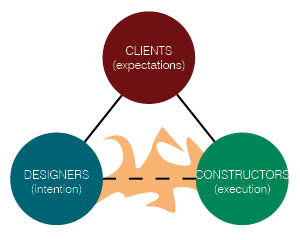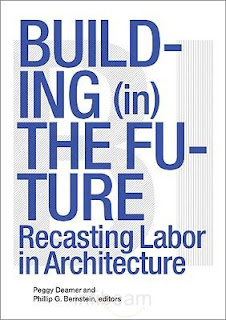Last night, I attended the book launch of, BUILDING in THE FUTURE: Recasting Labor in Architecture. The speakers/contributers were: Peggy Deamer (theorist), Phillip G. Bernstein (technologist), Christ Noble (legalist), and Scott Marble (architect). These four seemingly wildly disparate individuals have come together to produce a cohesive and in-depth analysis of our profession today, and a prediction of where it will go in the future.
Each spoke of their viewpoint and contribution to the work, which, as Peggy summarized deals with:
1. The work we do as architects, not the products we make.
2. New technologies, but with the viewpoint that while these do support change, they are not the driving force behind such changes.
3. Our profession cannot invoke change while examining work in silos of productivity, but rather we must examine together across fields of discipline.
4. A theoretical examination need not be an abandonment of critical work, but rather a catalyst for the progression of such work.
I have highlighted a universal subject prominent in Phillip's talk below:

As you can see, Phillip discussed an idea I seem to keep running into: the popular notion of the moment that Integrated Product Delivery will be the future of building, the future of our profession. The above diagram represents the ambiguity now present between designers and constructors. Each holds a specific role, yet somewhere in between intention and execution, the linkage breaks down. Phillip raised the question, what causes this rift? Is this a question of power, productivity, or profit? A combination of the three? Ultimately, what causes this gulf of separation is the dichotomy between risk and reward. The issue now on the table: how do we break down this boundary we have spent years working to establish?
Ironically (or perhaps not), this talk raised many of the same questions the same topic did back in Chicago. For example:
Q: Is IPD synonymous with BIM technologies?
Panel answer: No, of course not. However, by the time IPD is truly a universal practice, two dimensional representations of built work will be a thing of the past.
Q: What would stop contractors from taking 'cartoon sketches' of ideas from architects and creating their own BIM models? In other words, won't this devalue the need for an architect even further?
(Somewhat nerve wracking) Panel answer: The progression of our field is up to us as architects. Contractors have already started doing just that, making it imperative that we embrace these technologies and use them to our benefit.
This brought up an excellent thought from the evening: the transition from pen to computer drafting was evolutionary, yet the transition we now face from computer drafting to Building Information Modeling will be revolutionary. This is no small feat, but rather a dynamic shift in the way our future will be designed and built.
Q: How will this help us to make more money/get sued less?
Panel answer: It is a bad habit to look to contractual documents to solve our problems. These problems need to be solved with design and with collaboration instead. They went into great detail siting personal examples of previous work, you will have to read the book for more details.
Q: How will this serve the end user? How will someone untrained in complex model software be able to use this work for building maintenance in the future?
(Radical) Panel answer: In the future, end users will simply be able to point their IPhone, IPad, I(whatever apple comes up with next) at a portion of their completed building and access Building Information Modeling information. For a very prosaic example, a light needs to be replaced - interject IPhone magic - instructions: buy X light and obtain ladder.
I simply cannot do justice to the work of these incredible individuals in a single blog post. Instead in conclusion, I commend the four speakers for a cohesive and thought provoking evening, and encourage you to read their newly released work:

I leave you with this thought, which I believe Phillip stated as the presentation concluded: 'It takes a recession for the building industry to be truly reflective and begin to make changes'.
This thought, I think, can leave us all with hope for what lies ahead for the profession and for our built communities.


